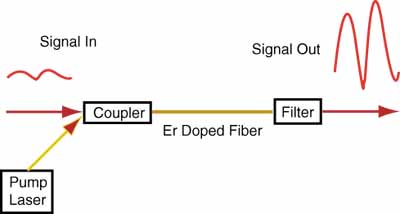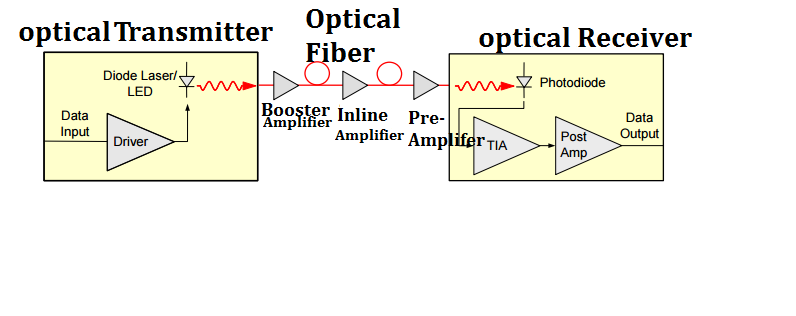With the rapid development of the optic communication networks, longer transmission lengths are required. Optical amplifier can satisfy the requirements of optical communication networks. An optical amplifier is a device that amplifies an optical signal directly, without the need to first convert it to an electrical signal. An optical amplifier may be considered as a laser without an optical cavity, or one in which feedback from the cavity is suppressed. This post is going to help you get a better understanding of optical amplifier.
A basic optical communication link contains a transmitter and receiver, with an optical fiber cable connecting them. Although signals transmitting in optical fiber suffer far less attenuation than in other mediums, such as copper, there is still a limitation about 100 km on the distance the signals can travel before becoming too noisy to be detected.
Optical amplifiers are widely used in fiber optic data links. Figure 1 shows three ways in which optical amplifiers can be used to strengthen the performance of optical data links. A booster amplifier is used to increase the optical output of an optical transmitter just before the signal enters an optical fiber. The optical signal is attenuated as it travels in the optical fiber. An inline amplifier is utilized to restore (regenerate) the optical signal to its original power level. An optical pre-amplifier is operated at the end of the optical fiber link in order to increase the sensitivity of an optical receiver.
Figure 1. Optical amplifiers in fiber optic communication links
- Ratio of output power to input power
- Gain as a fuction of inpout power
- Range of wavelengths over which the amplifier is effective
- Maxmum output power, beyond which no amplification is reached
- undesired signal due to physical processing in amplifier
There are three most commonly used types of optical amplifiers, as shown from left to right: erbium-doped fiber amplifier, the semiconductor optical amplifier, and the fiber Raman amplifier.

The amplifying medium is a glass optical fiber doped with erbium ions. The erbium is pumped to a state of population inversion with a separate optical input. The erbium-doped glass optical gain medium amplifies light at wavelengths that are in the neighborhood of 1550nm – the optical wavelengths that suffer minimum attenuation in optical fibers. The erbium-doped fiber amplifier (EDFA) is the most deployed fiber amplifier. Erbium-doped optical fiber amplifiers (EDFAs) have low noise and can amplify many wavelengths simultaneously, making the EDFA the amplifier of choice for most applications in optical communications.

Figure 2. Erbium-doped fiber amplifier working principle
The gain medium is undoped InGaAsP. This material can be tailored to provide optical amplification at wavelengths near 1.3 µm or near 1.5 µm – important wavelengths for optical communications. Other semiconductors can be used to amplify optical signals at other wavelengths. The input and output faces of the amplifier are antireflection coated in order to prevent optical feedback to the gain medium and lasing. Semiconductor Optical Amplifier with its features of small package, low-cost applications and potential use for optical switching, it can be a great choice to suit most customers.
Figure 3. Semiconductor optical amplifier working principle
In a Raman amplifier, the signal is intensified by Raman amplification. Unlike the EDFA and SOA the amplification effect is obtained by a nonlinear interaction between the signal and a pump laser within an optical fiber. There are two types of Raman amplifier: distributed and lumped. A distributed Raman amplifier is one in which the transmission fiber is utilized as the gain medium by multiplexing a pump wavelength with signal wavelength, while a lumped Raman amplifier utilizes a dedicated, shorter length of fiber to provide amplification.

Figure 4. Raman amplifier working principle
Optical amplifier plays a very important role in modern optical networks, enabling the transmission of many terabits of data over long distances of up to thousands of kilometers. Optical amplifiers provided by Fiberstore are designed for all network segments and applications. For more information please visit fs.com.

